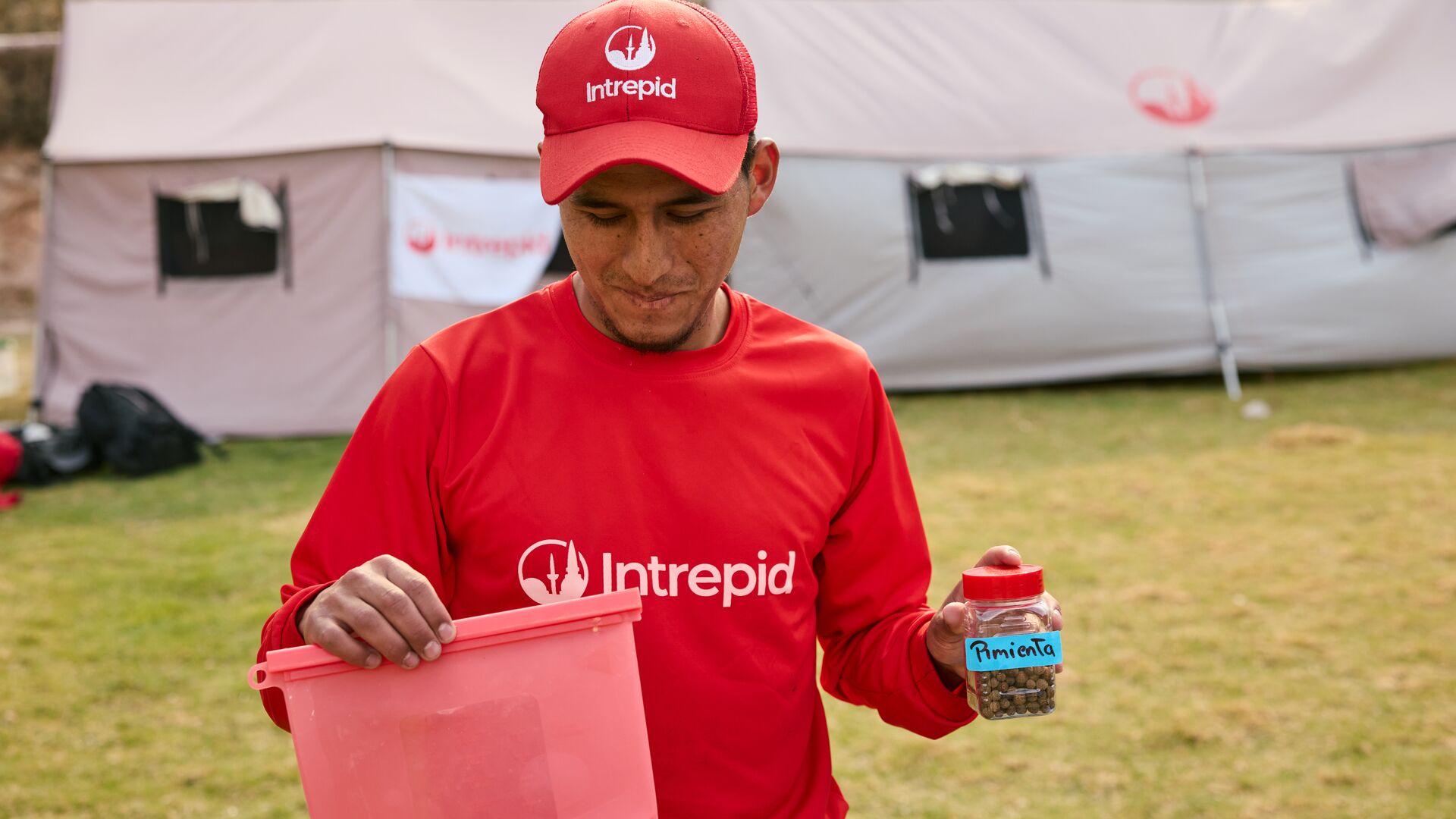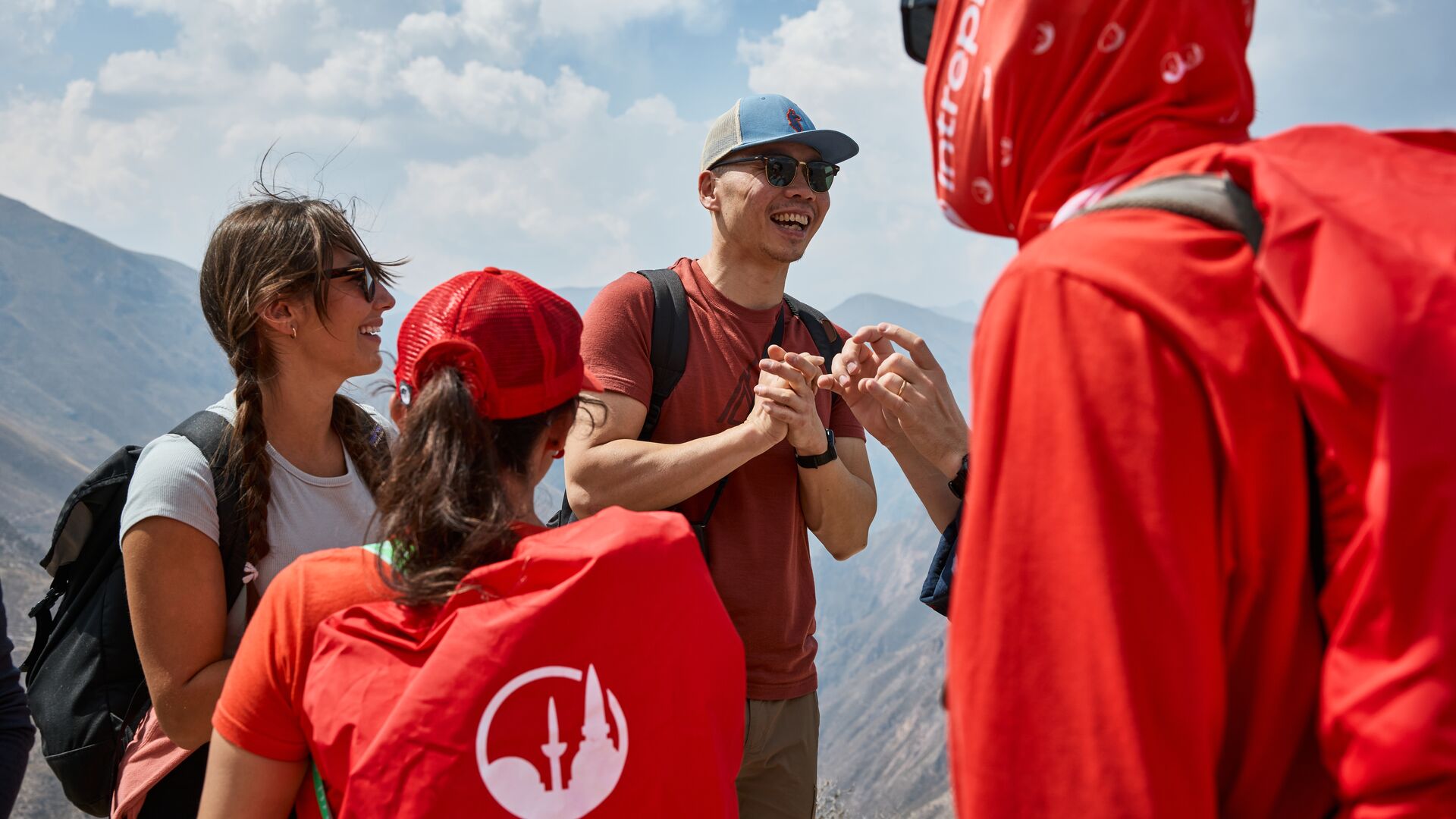For 11 months of the 12 months, about 160,000 individuals – together with travellers, tour guides, cooks and porters – hike the traditional roads and trails that traverse the Andes and result in Machu Picchu, the Inca Empire’s sacred metropolis. Because the third largest operator on the path, Intrepid is effectively conscious of the duty they carry to maintain these trails in fine condition. So when crews began to note the single-use plastic waste piling up, they felt compelled to do one thing about it.
It was October, and Paul Garrido, a seasoned Intrepid chief from Cusco, was main a gaggle throughout one of the vital well-known mountaineering trails on the earth, the Inca Path. He’s used to answering travellers’ questions, however one query on that journey made him mirror deeper: ‘The place do all of the ponchos find yourself?’ enquired a lady from Melbourne. Although it was dry season on the Inca Path, most travellers had purchased a plastic poncho for $1 USD in case the climate turned.
Contemplating the a whole lot of travellers Paul had guided alongside these trails over time – most of whom had one in every of these single-use, hardly ever repurposed nor recycled ponchos stashed of their daypack – it was a good query: The place does all that single-use plastic go, and what can we do about it?

A altering mindset
‘On the Inca Path, issues are executed a technique as a result of that’s the way it has all the time been,’ says Fernando Rodríguez, common supervisor for Intrepid in Peru. ‘It was a given amongst path operators that hikers would purchase the single-use plastic poncho, whatever the climate circumstances, as a result of there wasn’t one other selection. It was a wake-up name for us to determine what else we might do to minimize the environmental impression of our experiences. It was there that we realised there was far more to do.’
It wasn’t the primary time the group had thought of its impression on the path. Because the third largest official operator of the Inca Path – of about 260 companies with official operator permits that run journeys at the least every year – Intrepid started its efforts to make small however impactful adjustments to cut back single-use plastic (SUP) in 2021 by partnering with the Peruvian Setting Minister overseeing tourism operations on the path.
‘At that time, we have been a part of the official pilot program to do a one-day Inca Path expertise 100 per cent SUP free. There was no have to arrange camp, and it solely required offering one meal, so we built-in containers produced from sugarcane fibre, changed SUP water bottles with reusable cups and provided fruits that present hydration,’ explains Fernando.
Over time, they began to assume: if they may take this method to one-day journeys, might they apply it to multi-day tenting treks? On a three-day trek, for instance, crews pack and carry the group’s tenting and cooking tools, all meals and drinks plus any waste accrued all through the journey. If that features meals packaging for as much as 16 travellers and 26 crew plus single-use water bottles and ponchos, that waste can accumulate rapidly.
‘Operators are required by the Peruvian authorities to separate their rubbish – natural, inorganic and human waste – and take away it from the Inca Path,’ says Fernando. ‘Nevertheless, as soon as the rubbish is out, it‘s often positioned in a dumpster and brought out on the practice, however we have now no approach of understanding what occurs after that.’
At this time, Intrepid has lowered its use of SUP by 90 per cent. When you think about Intrepid takes over 2000 individuals onto the Inca Path in a 12 months, these reductions make a giant distinction.


Enter two SUPerheroes of the Inca Path
None of this might be doable with out the long-standing efforts of Maritza Chacacanta, a local Quechua girl and operations supervisor with at the least 500 Inca Path hikes beneath her belt, and Robert Franco, a second-generation Quechua porter who’s now Intrepid’s trek supervisor overseeing SUP discount efforts.
With their deep connection to the Inca Path and generational data of the dynamics and logistics of supporting these treks, Maritza and Robert are two of the Intrepid masterminds behind new and novel options for SUP discount. An enormous piece of that has been swapping out SUP luggage and packaging for reusable containers – assume silicone, paper, cardboard or material – to move meals and water. It’s not all the time as straightforward as it’d sound when you think about the logistics of catering to a gaggle and shopping for in bulk.
‘For instance, the plastic wrap of most commercially obtainable snacks in Peru has a shiny reflective layer, making it unfit for recycling,’ Fernando says. ‘So we partnered with a small native firm from Cusco that already had a sustainable and low-environmental impression imaginative and prescient to supply natural snacks with recyclable wraps.’
One of many last items of the meals storage puzzle was procuring the proper reusable container to hold spaghetti. The crew wanted one thing sturdy sufficient and lengthy sufficient to guard the delicate noodles, and it wasn’t like selecting a much less rectangular noodle that will match a greater variety of container shapes would do – spaghetti actually is essentially the most packable and moveable noodle once you’ve obtained plenty of mouths to feed on a multi-day hike.
Trek cooks additionally acquire used cooking oil and donate it to the municipality to show into cleaning soap, whereas additionally amassing bottle lids and donating them to non-profits to allow them to elevate funds.
‘We’re dedicated to donating our journeys’ natural waste to native communities and farms on the Quarry Path for animal feed,’ Fernando provides. ‘Intrepid additionally has an alliance with Ollantaytambo’s municipality to eliminate inorganic waste.’
Plus, gone are the single-use disposable ponchos and now all trekkers can borrow a reusable poncho for his or her journey.
Bottle by bottle, brick by brick
A way of curiosity and a steadfast decision to do extra drove Robert on a journey to determine what to do with all of the SUPs unfit for recycling. ‘At some point, Robert known as Maritza a few video he noticed on YouTube about repurposing single-use plastic to create bricks and construct partitions with assist from additional wiring and structural bars,’ explains Fernando.
With a studying curve and adamant waste separation supervision, Robert and Maritza have utilized their newfound data to constructing wanted partitions and fences for Intrepid’s trekking warehouse on the outskirts of Ollantaytambo utilizing selfmade SUP bricks.
Their purpose is to make tables and chairs to enhance the lounging amenities for porters on the warehouse and donate some to native faculties. They assume if Quechua communities begin seeing the chances with the SUP bricks, they may apply them at house.
‘Our crews have gone a step additional by additionally selecting up the discarded SUP we come throughout alongside the path to carry again to our warehouse after which flip it into bricks,’ provides Fernando.
Learn extra: Meet Maritza, the Intrepid supervisor cleansing up Peru


A contagious awakening for a objective
Fernando sees Intrepid’s efforts as a chance for all Inca Path operators. Because the third largest participant within the area’s journey trade, Fernando and his group need to lead by instance.
‘Whatever the quantity of tourists every operator welcomes in a 12 months, all of us face the identical challenges,’ Fernando explains. The final word purpose is to show that small however significant adjustments have a major impression and, extra importantly, to open alternatives for partnerships and alliances with native authorities and the non-public sector. ‘If Intrepid exhibits that it may be executed, then fellow Inca Path operators can do the identical,’ he emphasises.
For greater than 500 years, the Quechuas have walked the Inca Path with a deep respect for the land and Pachamama, or Mom Earth. Again within the day, there have been neither SUP ponchos nor snack wraps. At this time, travellers from all around the world can trek the identical path because the Incas; nevertheless, the privilege comes with tasks.
‘There may be an amazing feeling once you arrive in Machu Picchu after mountaineering the Inca Path for 3 days,’ displays Fernando. ‘Each effort – whether or not bodily or emotional – is price it when you arrive on the Sacred Metropolis. The fantastic thing about the panorama and the individuals you share the expertise with. Intrepid needs a extra sustainable behind-the-scenes to this expertise and to lift the bar amongst path operators for the frequent good.’
Learn how to make a brick out of single-use plastic
- Discover a bigger (one- to two-litre) bottle with a lid. This will likely be your brick.
- Acquire, wash and dry comfortable single-use plastic waste like meals packaging.
- Squish items of your comfortable plastic waste into the bottle. Use a keep on with press it down. You may want to chop or rip your plastic into smaller items.
- Hold squishing and squashing! The purpose is to get the plastic contained in the bottle as tightly packed as doable – so tight you’ll be able to stand on the bottle with out denting it.
- When it’s totally packed, screw the lid again on the bottle. Marvel at your new brick!
In search of a low-impact journey? Depart the plastic poncho behind and trek to Machu Picchu with Intrepid.

